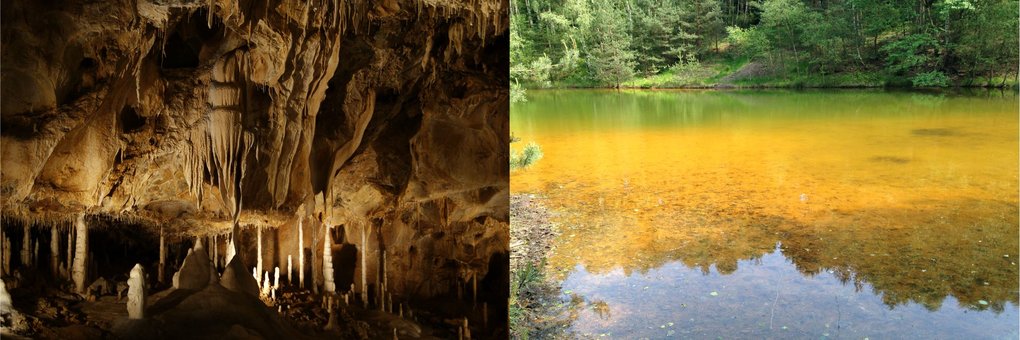

Head of the LUT.: dr hab. Michał Gąsiorowski
Institute of Geological Sciences PAS
Research Center in Warsaw
Twarda 51/55, 00-818 Warsaw (Poland)
Phone: (48) 22 6978-742
e-mail: mgasior@twarda.pan.pl

Research fields:
Team members:
Current research projects:
Selected publications:
Gąsiorowski, M., Hercman, H., Pruszczyńska, A., Błaszczyk, M., 2015. Drip rate and tritium activity in the Niedźwiedzia cave system (Poland) as a tool for tracking water circulation paths and time in karstic systems. Geochronometria 42, 210–216, 10.1515/geochr-2015-0025
C. Durlet, V. Bichet, J. Buoncristiani, Š. Matouskova, P. Sierpień and N. Bondon. “Discovery and deciphering of a long intra-till cave (Jura mountains, France)”, 2024, Geomorphology 461(1):109319, https://doi.org/10.1016/j.geomorph.2024.109319
Sekudewicz, I., Syczewski, M., Rohovec, J., Matoušková, Š., Kowalewska, U., Blukis, R., Geibert, W., Stimac, I., & Gąsiorowski, M., 2024. Geochemical behavior of heavy metals and radionuclides in a pit lake affected by acid mine drainage (AMD) in the Muskau Arch (Poland). Science of The Total Environment, 908, 168245. https://doi.org/10.1016/J.SCITOTENV.2023.168245
Sekudewicz, I., & Gąsiorowski, M., 2022. Spatial and vertical distribution of 137Cs activity concentrations in lake sediments of Turawa Lake (Poland). Environmental Science and Pollution Research International, 29(53). https://doi.org/10.1007/S11356-022-21417-1
Sekudewicz, I., Matoušková, Š., Ciesielska, Z., Mulczyk, A., & Gąsiorowski, M., 2022. Factors controlling 137Cs distribution in bottom sediments of Koronowo Reservoir (Poland). Journal of Soils and Sediments, 22(12), 3189–3208. https://doi.org/https://doi.org/10.1007/s11368-022-03326-5
M. Gąsiorowski, J. Stienss, E. Sienkiewicz, and I. Sekudewicz, “Geochemical Variability of Surface Sediment in Post-Mining Lakes Located in the Muskau Arch (Poland) and Its Relation to Water Chemistry,” Water. Air. Soil Pollut., vol. 232, no. 3, pp. 1–12, Mar. 2021.
I. Sekudewicz, A. M. Dąbrowska, and M. D. Syczewski, “Microplastic pollution in surface water and sediments in the urban section of the Vistula River (Poland),” Sci. Total Environ., vol. 762, p. 143111, Mar. 2021.
N. Zupan Hajna et al., “Pliocene to Holocene chronostratigraphy and palaeoenvironmental records from cave sediments: Račiška pečina section (SW Slovenia),” Quat. Int., vol. 605–606, pp. 5–24, Dec. 2021.
J. Pawlak, M. Błaszczyk, H. Hercman, and Š. Matoušková, “Palaeoenvironmental conditions during MIS 6/MIS 5 transition recorded in speleothems from the Tatra Mountains,” Boreas, vol. 50, no. 1, pp. 224–241, Jan. 2021.
A. R. Paine et al., “The trace-element composition of a Polish stalagmite: Implications for the use of speleothems as a record of explosive volcanism,” Chem. Geol., vol. 570, p. 120157, Jun. 2021.
M. Błaszczyk, H. Hercman, J. Pawlak, and J. Szczygieł, “Paleoclimatic reconstruction in the Tatra Mountains of the western Carpathians during MIS 9–7 inferred from a multiproxy speleothem record,” Quat. Res., vol. 99, pp. 290–304, Jan. 2021.
M. Gąsiorowski, E. Sienkiewicz, U. Ciołko, K. Kaucha, M. Kupryjanowicz, and M. Szal, “Cultural eutrophication of a Central European lowland lake from the Bronze Age to the present recorded in diatom and Cladocera remains,” CATENA, vol. 204, p. 105404, Sep. 2021.
H. Hercman, M. Gąsiorowski, J. Pawlak, M. Gradziński, Š. Matoušková, P. Zawidzki, P. Bella. Atmospheric circulation and the differentiation of precipitation sources during the Holocene inferred from five stalagmite records from Demänová Cave System (Central Europe), The Holocene, 30, pp. 834-846, 2020.
J. Szczygieł, H. Hercman, G. Hoke, M. Gąsiorowski, M. Błaszczyk, A. Sobczyk. No valley deepening of the Tatra Mountains (Western Carpathians) during the past 300 ka. Geology, 48, pp. 1006–1011, 2020.
J. Pawlak, H. Hercman, P. Sierpień, P. Pruner, M. Gąsiorowski, A. Mihevc, N. Zupan Hajna, P. Bosák, M. Błaszczyk, B. Wach. Estimation of the durations of breaks in deposition – Speleothem case study, Geochronometria, 47, pp. 154–170, 2020.